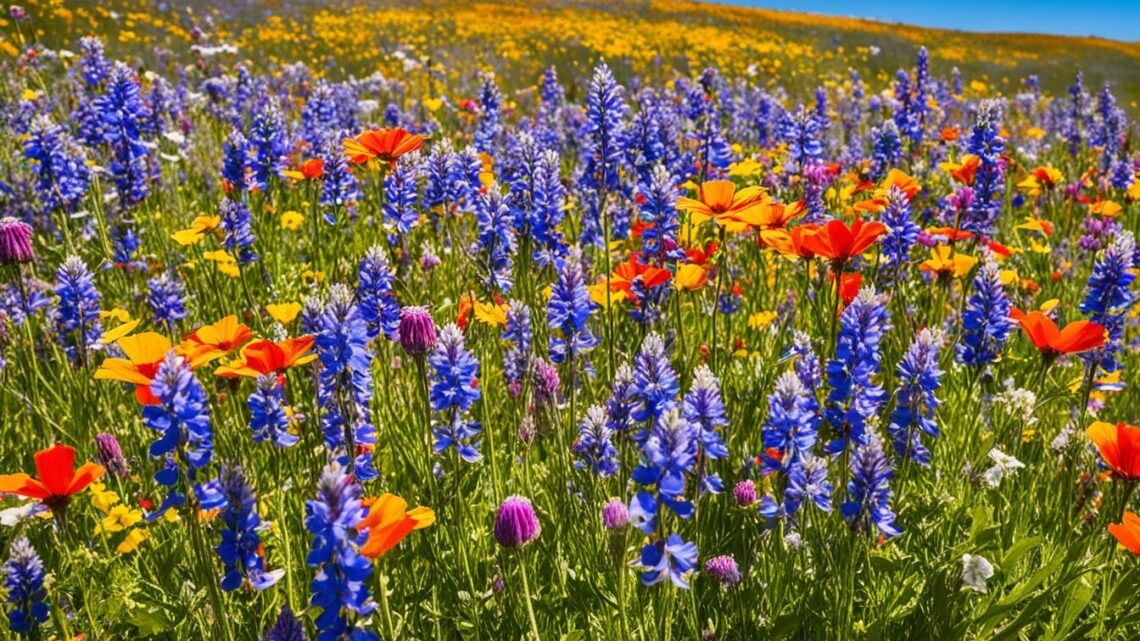
Ever wonder about the magic in flowers blooming every year? From spring’s vibrant start to winter’s cozy end, nature shows us its beauty. Join us as we dive into the world of seasonal blooming. We’ll learn about the magic behind it.
This guide will show you the cycles of flowers blooming. You’ll see how daffodils and tulips start in spring and roses and dahlias in summer. We’ll talk about how nature changes with the seasons.
If you love gardening or just enjoy nature, this guide will make you appreciate flowers more. Get ready to learn about when, where, and why flowers bloom.
A Love Affair with Flowers
For many, flowers bring deep feelings and a strong bond. They are a wonder that makes us feel amazed and happy. People love the beauty and art in flowers, which brings us together.
Discovering Nature’s Artistry
Flowers take our breath away with their beauty. Each part of them shows nature’s skill. From roses to sunflowers, they are a feast for our eyes.
Kindred Spirits: Flowers and the Soul
Flowers mean more than just beauty to some. They touch our hearts and lift our spirits. They can symbolize love, thanks, or joy in life.
Exploring flowers shows us their power to touch our feelings. They connect us to nature and our inner selves. Let flowers take you on a journey of self-discovery and connection.
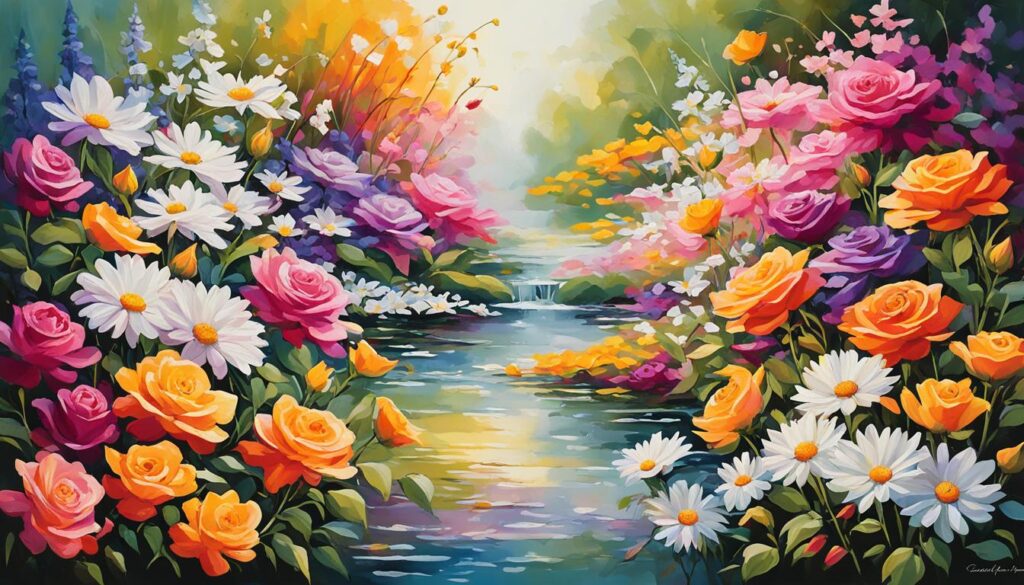
Spring’s Floral Awakening
As winter’s cold fades, the world comes alive with spring blooms. This season brings seasonal renewal. Flowers like daffodils and tulips start a new cycle of growth. They fill the air with color and scent, bringing hope and new life.
Spring’s blooms start when the weather gets warmer. In some places, white butterfly ranunculus and yellow mustard flower stems bloom first. In other areas, Armand clematis vines and black-eyed anemones bloom, showing nature’s beauty and strength.
As days get longer and sun shines brighter, more flowers bloom. Gardeners might switch to pale purple tulips or narcissus. Cutting spirea branches adds beauty, replacing mustard blossoms. These choices show the gardener’s style and the changing seasons.
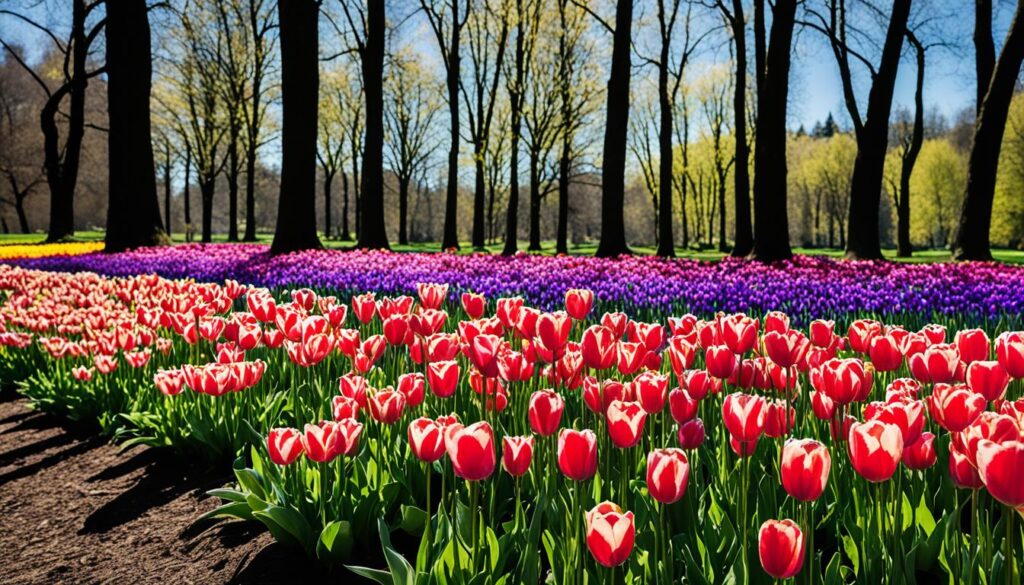
The spring blooms make us stop and enjoy nature’s beauty. From the first buds to the full blooms, they show nature’s strength and growth. Let spring’s flowers fill you with wonder and love for nature.
Summer’s Vibrant Bloom Cycles
When summer comes, gardens fill with colorful summer flowers. This part talks about the bright blooms of the season. It highlights perennial blooms and pollinator-friendly plants that love the heat.
Heat-Loving Perennials
Some perennials love the summer heat. They add color and texture to the garden for a long time. Stella d’Oro daylilies bloom all summer, handling hot, dry places well. Endless Summer hydrangeas bloom many times.
Knock Out roses bloom almost non-stop and don’t get sick easily. Jackmanii clematis blooms early summer and then some more throughout the season.
Pollinator Powerhouses
Summer flowers are key for helping pollinators like bees, butterflies, and hummingbirds. May Night perennial salvia blooms again if you cut the flowers as they fade. Rozanne geranium shows off purple flowers from late spring to fall.
Commotion Tizzy blanket flower loves the sun and blooms all summer. Valerian keeps blooming from spring to fall in sunny spots.
| Flower | Bloom Time | Characteristics |
|---|---|---|
| Coreopsis | Summer | Produces scores of yellow flowers, re-blooming if spent blossoms are removed |
| Becky Shasta daisy | Summer | Rewards with a repeat showing if dead flowers are removed |
| Walker’s Low catmint | Summer | Requires a haircut after the first flower flush to initiate another bloom cycle |
| Speedwell | Summer | A perennial that blooms all summer, coming in blue, pink, or white varieties, requiring shearing after the first blooms fade to encourage reblooming |
| Rose verbena | Spring and Fall | Blooms best in the cooler weather |
| Butterfly Blue pincushion flower | Summer | A nonstop bloomer attracting butterflies, reaching 12 to 15 inches tall |
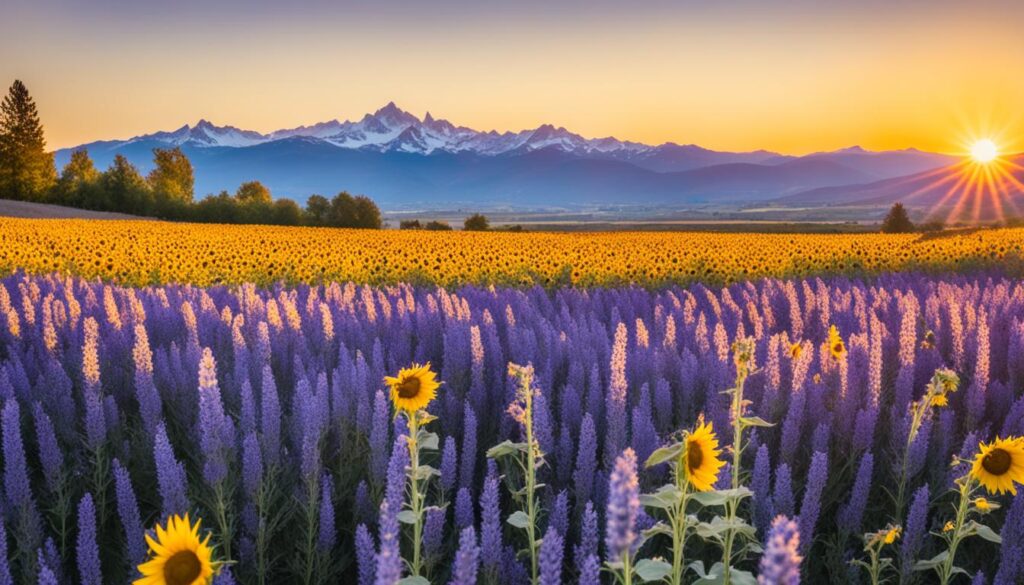
Autumn’s Rich Tapestry
Summer fades away as autumn comes, changing the landscape into a colorful and textured tapestry. This season shows off autumn flowers and fall foliage. It celebrates the seasonal transitions with amazing artistry.
Decadent Hues and Hardy Blooms
The autumn flowers are a treat for our senses. Chrysanthemums, asters, and other strong flowers stand out. They love the cooler weather, making a beautiful contrast with the leaves.
These flowers show off colors like fiery reds, oranges, plums, and purples. They create a stunning natural beauty.
Autumn’s flowers show how nature can adapt and be strong. While summer flowers disappear, autumn flowers come out. They keep the landscape beautiful during the change. Enjoy this special time when nature shows off its best.
| Autumn Flower | Bloom Time | Characteristics |
|---|---|---|
| Chrysanthemum | September – November | Vibrant, long-lasting blooms in a variety of colors |
| Aster | August – October | Daisy-like flowers in shades of purple, pink, and white |
| Marigold | September – November | Warm-hued blooms with a distinctive spicy scent |
| Zinnia | August – October | Robust, long-flowering plants in a rainbow of colors |
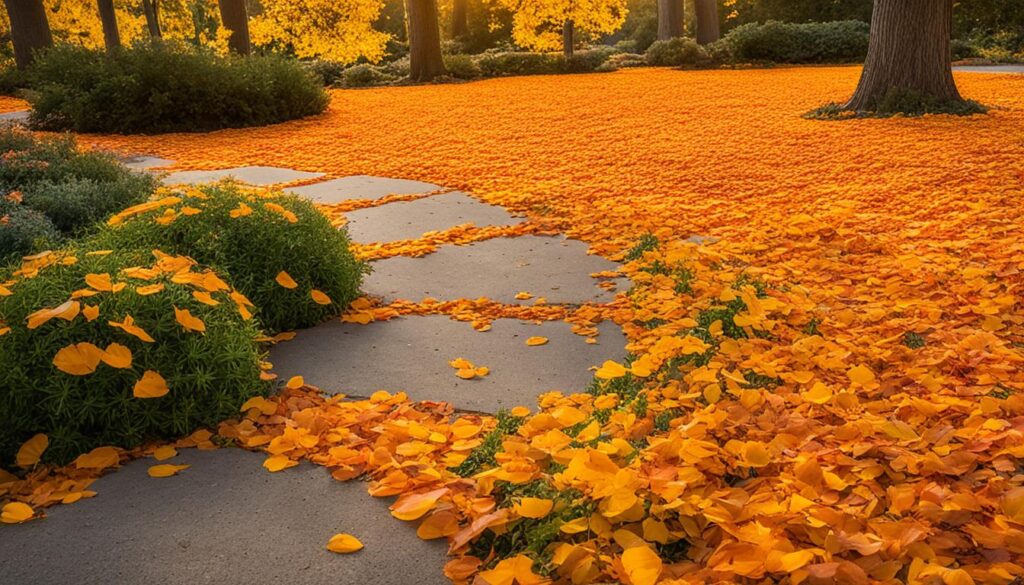
Winter’s Floral Delights
Winter may seem bare, but it’s full of floral surprises. Explore the world of winter flowers. Here, resilience and beauty come together in a stunning display.
The Winter Rose (Hellebores) is a winter treasure. It has rich, jewel-toned blooms in deep purples to soft pinks. These flowers add elegance to winter bouquets.
The Camellia blooms in pink, red, and white. It brings diversity and interest to winter flowers. The Snowdrop has white petals with green hints. It symbolizes renewal and hope in winter.
The Winter Daphne and Winter Sweet flowers have sweet scents. The Witch Hazel has spidery, vibrant blossoms. They surprise us with their beauty in winter.
These flowers show nature’s resilience in winter. They bring a subtle beauty to the season. Let’s appreciate winter’s floral wonders and their magic.
| Flower | Bloom Time | Distinguishing Features |
|---|---|---|
| Winter Rose (Hellebores) | Winter | Rich, jewel-toned blooms ranging from deep purples to soft pinks |
| Camellia | Winter | Vibrant pink, red, and white hues |
| Snowdrop | Winter | Pristine white petals tinged with hints of green, symbolizing hope and renewal |
| Winter Daphne (Daphne odora) | Winter | Clusters of pale pink or white blossoms with a heavenly fragrance |
| Winter Sweet | Winter | Flowers in shades of yellow or white with a sweet fragrance |
| Witch Hazel | Winter | Spidery, fragrant blossoms in shades of yellow, orange, and red |

These winter flowers are resilient and fragrant. They bring warmth and beauty to the cold months. Let’s enjoy nature’s winter blooms and add them to our arrangements for a unique look.
Seasonal Blooming Cycles
The annual rhythm of flower blooms is a captivating natural spectacle. Each season brings its own unique floral displays. From early spring blossoms to late spring beauties, the progression shows Mother Nature’s artistry.
Early Spring Blossoms
As the vernal equinox comes, early spring blossoms start to show. They signal the start of the seasonal flowering cycle. Lenten roses, crocus, and hyacinths are among the first to bloom, with vibrant colors and delicate petals.
These perennials thrive in the cool, damp early spring. They set the stage for the floral abundance to come.
Late Spring Beauties
As days get longer and temperatures rise, late spring beauties take over. Peonies, azaleas, and lilacs bloom, captivating us with their fragrances and colors. This seasonal flowering period brings a surge of bloom progression.
The spring flowers transform the landscape into a tapestry of natural beauty.
Understanding the timing of these blooms is key to appreciating their beauty and rhythm. By embracing the bloom progression of spring flowers, we connect deeper with nature. We marvel at Mother Nature’s endless artistry.

when the flowers bloom
The blooming of flowers is tied to natural cycles. It signals new seasons and the renewal of nature. This part looks at the meaning of flowers blooming. It talks about nature’s cycles and the vernal equinox.
Nature’s Renewal
Flowers blooming show the strength and power of plants to come back to life. As seasons change, flowers blooming shows a big change. It’s like nature is saying, «I can always start again.»
Vernal Equinox Wonders
The vernal equinox is a key moment that makes flowers bloom. It’s when winter turns to spring. This brings many colorful flowers, each one showing the earth’s new life.
From the first daffodils of spring to the bright tulips, flowers blooming shows nature’s beauty. Watching this, we see the magic in our world.

If you love gardening or just nature, knowing when flowers bloom connects you to nature’s cycles. Enjoy the change that comes with the vernal equinox. Let the beauty of nature amaze you.
Summer’s Floral Splendor
When summer comes, gardens and landscapes show off floral splendor. This season brings vibrant blooms that highlight the abundance and variety of flowers. Discover summer flowers like roses and dahlias, and enjoy the color and scent they bring. The seasonal beauty of nature is truly amazing.
Sunflowers can grow really tall, making gardens bright and cheerful. Marigolds shine with golden-orange colors and are easy to grow. Zinnias come in many colors and are simple to care for. Coneflowers are tough and come in pink, purple, and white, perfect for hot summers.
Lavender loves dry summers and adds a calming scent to gardens. Most summer flowers need lots of sunlight and some can handle drought. They need good drainage and regular watering. Deadheading helps them bloom longer and more.
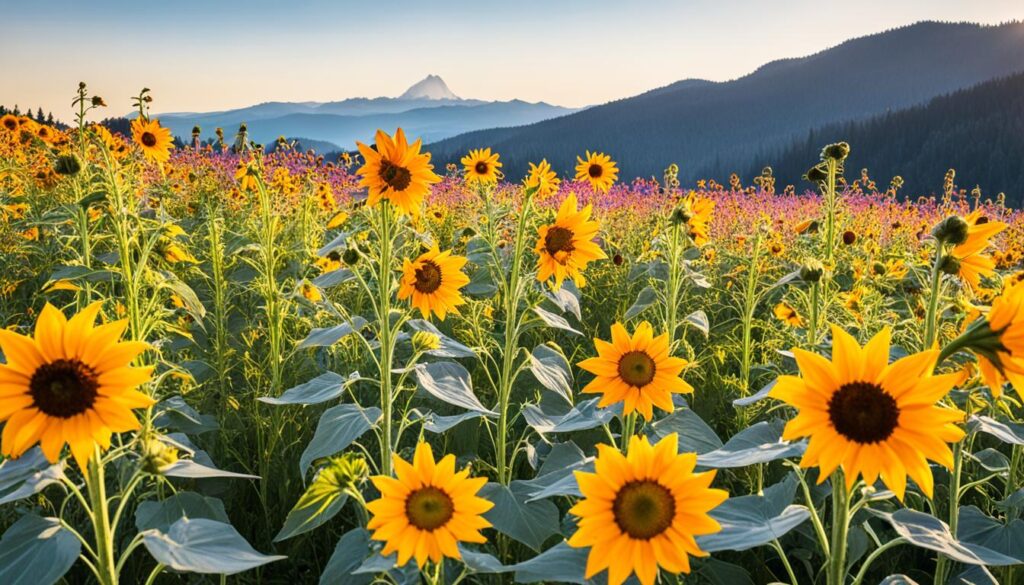
- Sunflowers (Helianthus annuus) can grow several feet tall.
- Marigolds (Tagetes) are a popular choice for summer gardens due to their rich, golden-orange hues.
- Zinnias (Zinnia elegans) are known for their spectacular array of colors and are one of the easiest flowers to grow.
- Coneflowers (Echinacea) come in several colors, including pink, purple, and white, and are drought-resistant.
- Lavender (Lavandula) is admired for its ability to withstand dry, hot summers and is perfect for sensory gardens.
With proper care, these summer blooms can make your garden look stunning. They celebrate the seasonal color of summer beautifully.
Autumn’s Textured Florals
As summer ends and autumn comes, the world changes into a colorful and textured place. The summer flowers fade, making way for vibrant chrysanthemums, asters, and other fall flowers. The mix of fall foliage and autumn flowers creates a beautiful scene.
September’s Lasting Color
September brings colors and beauty to the landscape. Flowers like sunflowers and asters add to the beauty of autumn. These flowers make the fall season more delightful.
| Flower | Hardiness | Light | Height |
|---|---|---|---|
| African Daisy | Annual except in zones 9-11 | Part sun to sun | 8-12″ tall |
| Bidens | Annual except in zones 9-11 | Sun | 8-14″ tall |
| Calibrachoa | Annual except in zones 9-11 | Part sun to sun | 6-12″ tall |
| Canna Lily | Annual except in zones 8-11 | Part sun to sun | 30-48″ tall, deer resistant |
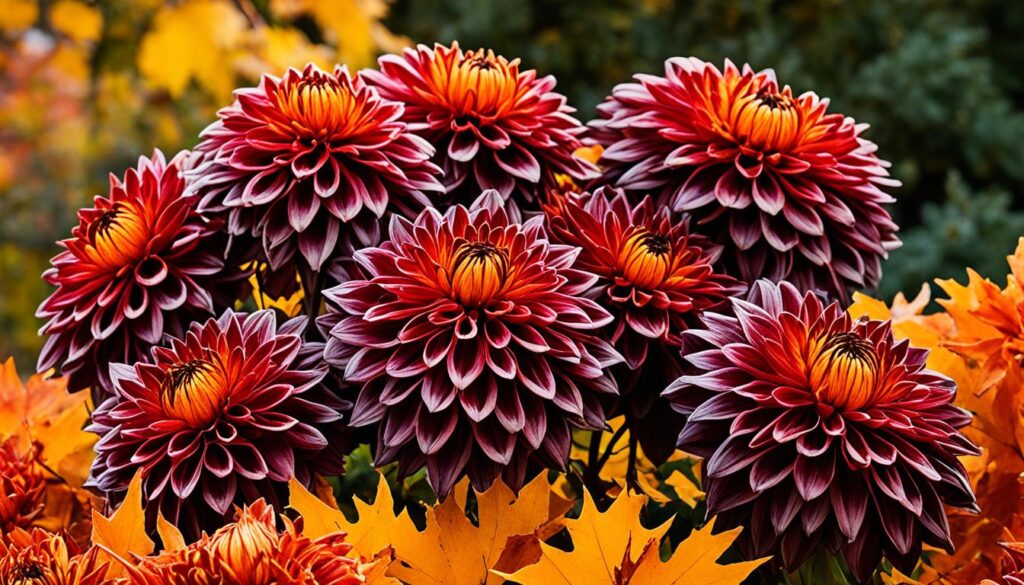
Chrysanthemums, or «mums,» are key autumn flowers with bright colors like red, orange, yellow, and deep purple. Asters have star-shaped flowers that add color to autumn. They are great for bouquets and decorations.
Fragrant Winter Florals
When winter comes, the world may look bare and lifeless. But, there’s a secret world of beautiful flowers waiting to be found. These flowers bloom in the cold, bringing warmth and joy to the season.
Winter jasmine, camellias, and witch hazel are just a few examples. They bloom in the cold months, offering beauty and a sweet smell. These plants are tough and make the winter season special.
The Lenten rose blooms in mid to late winter. Its rich colors and delicate petals stand out even in the snow. The winter aconite also appears, with bright yellow flowers, signaling spring is coming.
| Winter Flower | Bloom Period | Key Characteristics |
|---|---|---|
| Camellia | Late fall to mid-spring | Lush, long-lasting blooms in a range of colors |
| Witch Hazel | Late winter or early spring | Fragrant, wispy yellow or orange flowers |
| Mahonia | Late fall or early winter | Bright yellow, daffodil-like flowers with a sweet scent |
| Winter Jasmine | Late winter to early spring | Delicate yellow flowers that bloom on bare branches |
These fragrant winter florals are not just pretty. They also help early pollinators like bees. They are cold-hardy blooms that make winter brighter and lift our spirits.
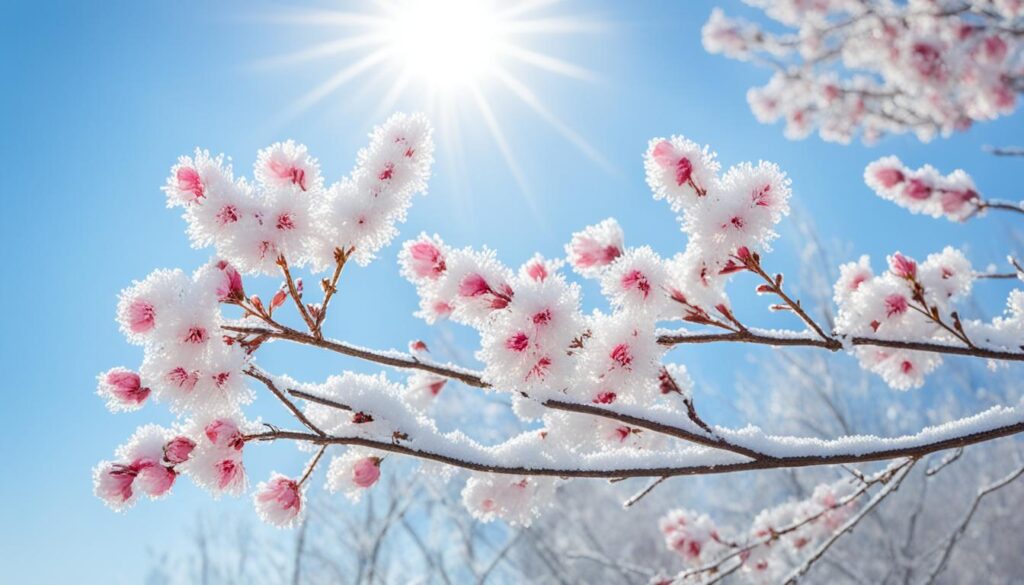
Knowing When Flowers Bloom
Flowers bloom at different times, thanks to many factors. These include where they are and the weather. Learning about this can teach us a lot about plants.
Regional Variations
Flowers bloom at different times around the world. This depends on where they are. Things like where they are on the map, how high up they are, and even the weather in small areas affect when they bloom.
In the north, some flowers bloom early. In the south, they bloom later. Flowers in the mountains bloom last because it’s cooler there.
Climate Considerations
Climate change is changing when flowers bloom. Scientists found a gene that makes plants flower. Because of climate change, this gene and many others are changing, making flowers bloom earlier or later.
This helps us understand how to deal with climate change and flowers.
| Flower Blooming Factors | Impact on Timing |
|---|---|
| Latitude | Northerly regions experience earlier blooms compared to southerly areas |
| Elevation | Higher altitudes see delayed blooms due to cooler temperatures |
| Microclimates | Localized weather patterns can create pockets of earlier or later blooms |
| Climate Change | Disruption of the Apetala1 gene and associated flowering processes leads to altered bloom timing |
Learning about how flowers bloom helps us enjoy nature more. It also helps us take care of the plants. We can plan for the seasons and protect nature’s balance.

Spring Blossoms Galore
As winter fades, the world comes alive with spring flowers and early-season blooms. Nature renews itself with bulb flowers like daffodils, tulips, hyacinths, and azaleas. These flowers signal spring’s start, filling the air with color and scent.
Daffodils and Tulips
Daffodils lead the way with their bright yellow petals and trumpet centers. They push through snow, welcoming warmer days. Tulips then bloom, adding elegance with their many colors to the spring flower scene.
Hyacinths and Azaleas
Hyacinths and azaleas add to the spring flower beauty. Hyacinths fill the air with their sweet scent. Azaleas show off in pink, white, and red, standing out against new green leaves.
| Flower | Bloom Time | Characteristics |
|---|---|---|
| Daffodils | Early Spring | Sunny yellow petals, trumpet-shaped centers |
| Tulips | Mid-Spring | Cup-shaped blooms in a variety of colors |
| Hyacinths | Early-to-Mid Spring | Fragrant, dense flower heads |
| Azaleas | Mid-to-Late Spring | Vibrant, clustered flowers in pink, white, and red |

Early-season blooms bring joy and have deep meanings. Daffodils symbolize rebirth, and tulips represent lasting love. As spring goes on, these spring flowers show nature’s power to renew. They invite us to enjoy the beauty of the seasons.
Summer’s Blooming Wonders
When summer comes, gardens and landscapes show off their best with lots of flowers. This section talks about the beautiful flowers that bloom in summer. You’ll see summer flowers like roses, dahlias, hydrangeas, and cosmos. These flowers bring lots of garden color and a sweet smell to the air.
Roses and Dahlias
Heirloom Roses are famous for their smell and variety. They come in climbers and shrubs of different sizes and colors. They bloom from June to September.
Knock-Out Roses don’t get blackspot or mildew easily. They bloom a lot and don’t need deadheading. They also come in many colors.
Dahlias come in many sizes and colors. They’re great for making arrangements and planting in big groups.
Hydrangeas and Cosmos
Hydrangeas love being in the shade and make big, beautiful flowers in blue, pink, and white. Cosmos are part of the daisy family. They add a light, airy feel to gardens with their pretty flowers in pink, white, and purple.
Both summer flowers bloom for a long time and attract bees and butterflies to the garden.
| Flower | Bloom Period | Growing Conditions | Key Features |
|---|---|---|---|
| Heirloom Roses | June – September | Full sun | Fragrant, variety of sizes and colors |
| Knock-Out Roses | June – September | Full sun | Resistant to common rose problems, profuse blooms |
| Dahlias | Summer | Full sun | Wide variety of sizes and colors, excellent for arrangements |
| Hydrangeas | Summer | Partial shade | Large, lush blooms in blue, pink, and white |
| Cosmos | Summer | Full sun | Delicate, vibrant flowers in pink, white, and purple |

Fall’s Floral Treasures
As summer’s warmth fades, autumn brings a colorful change. Chrysanthemums and asters bloom, adding energy to the season.
Chrysanthemums and Asters
Chrysanthemums come in many colors like fiery reds and warm oranges. Pitters and Outside Bunch types stand out with their bright petals. Asters add elegance with their jewel-toned flowers.
Rosehips, gourds, and crabapples brighten up autumn. Rosehips shine in red and orange, adding timeless beauty. Gourds and crabapples add warmth to arrangements.
Crocosmia berries bring vibrant colors to fall flowers. Their red, orange, and yellow add a pop of color. Together, these flowers make autumn beautiful.
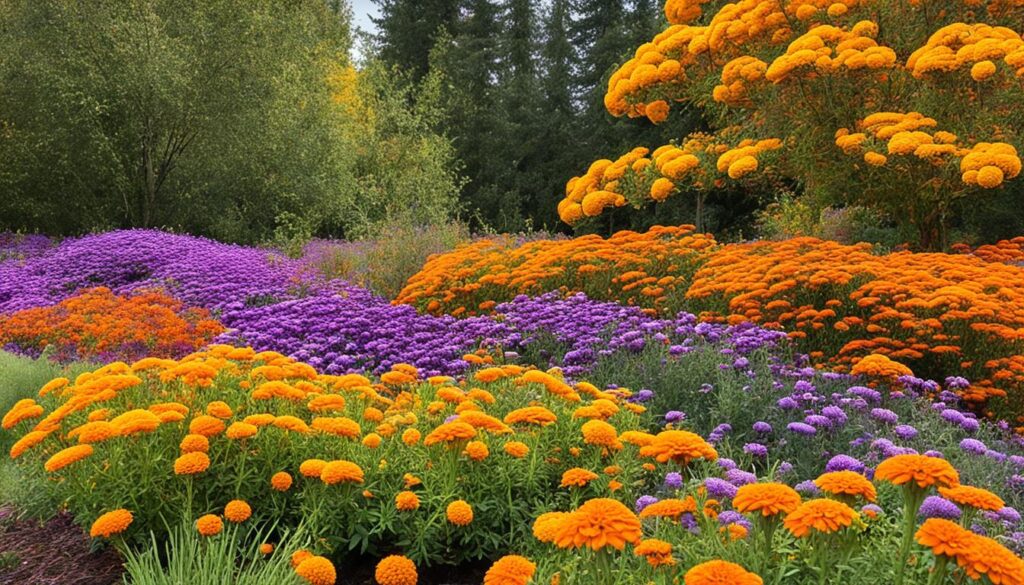
For fall flowers, check out Treasures To Adore in Humble, Texas. They offer autumn bouquets and arrangements. They focus on quality and personal service, sending flowers fresh to your place in Humble, Kingwood, Porter, Atascocita, and nearby.
Mother Nature’s Artistry
The blooming of flowers shows off the floral beauty and natural design of our world. These vibrant flowers amaze us with their beauty. They come in many shapes, colors, and sizes.
From the soft petals of peonies to the thick leaves of succulents, Mother Nature’s art is clear. Flowers make our world more beautiful and help nature too. They are important for our health and happiness.
Artists and designers love flowers for their inspiration. They find beauty in the floral beauty around us. The Balancing Mother Nature Collection has been featured in big magazines. It shows off the natural design of botanical wonders.
By looking at nature’s art, we feel closer to the flowers in our gardens. Artists and gardeners work together to make new and beautiful things. They mix sculpture, gardening, and the floral beauty of botanical wonders in their work.



